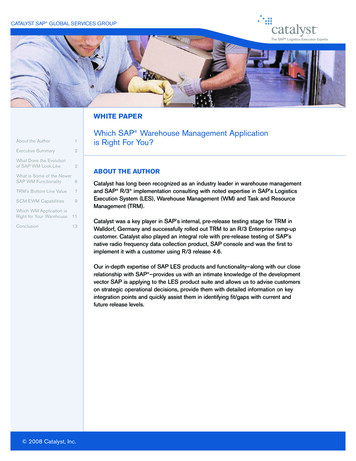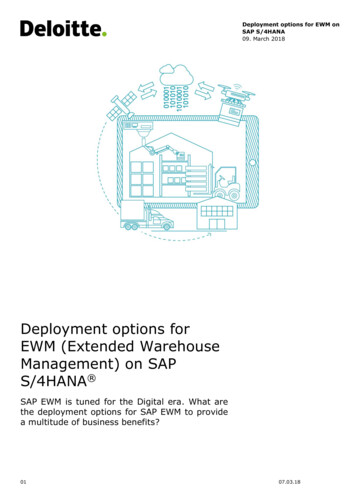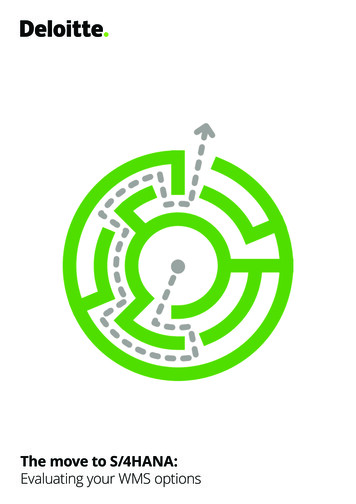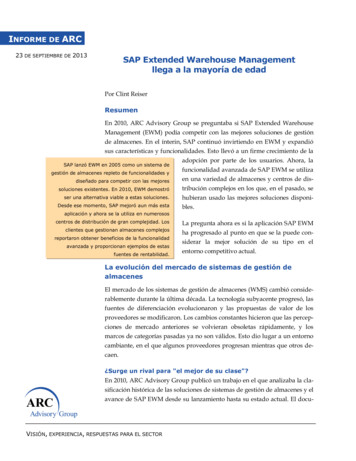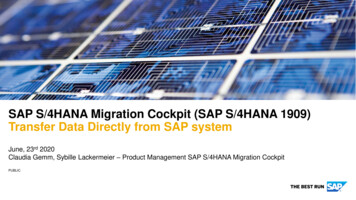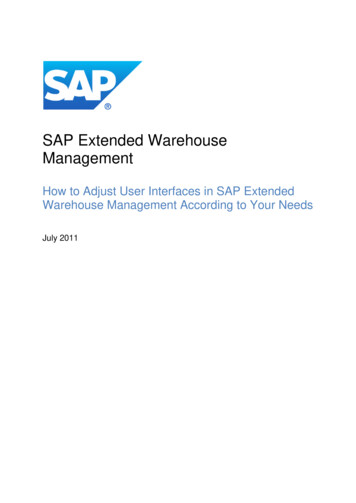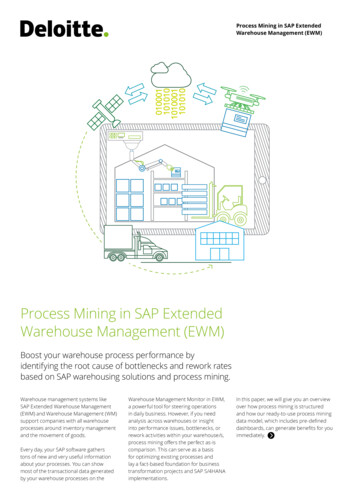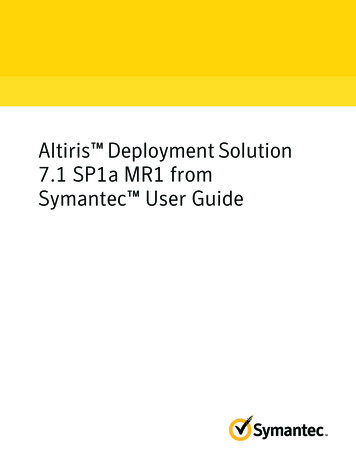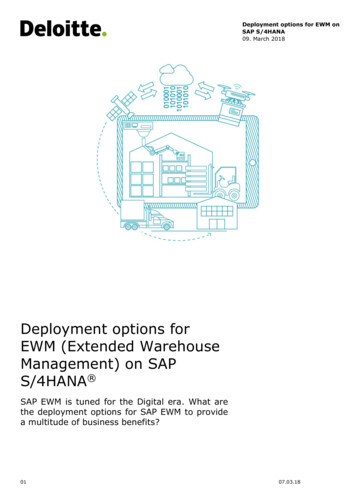
Transcription
Deployment options for EWM onSAP S/4HANA09. March 2018Deployment options forEWM (Extended WarehouseManagement) on SAPS/4HANA SAP EWM is tuned for the Digital era. What arethe deployment options for SAP EWM to providea multitude of business benefits?0107.03.18
EWM (ExtendedWarehouseManagement) isSAP’s strategicanswer to thechallenges ofincreasinglycomplexwarehouseoperations.What are the deploymentoptions for EWM with SAPS/4HANA?Clients can choose between twodeployment options broadly. Theycan select either an embedded EWMsolution or a decentralized EWM.Embedded EWMWith the 1610 release, SAP EWMwas offered as an embeddedapplication component. It is02commonly referred to as SAPS/4HANA Supply chain managementfor Extended WarehouseManagement or simply ‘EmbeddedEWM’ as the basic warehousefunctionality and SAP EWM arerunning on a common code,embedded within SAP S/4HANA.This is a default offering as part ofSAP S/4HANA 1610. SAP WM (theclassical WMS by SAP) also exists asa part of S/4 HANA, but isscheduled to be phased out by2025.illustration shows a quick differencein the two versions. The importantpoint to note is that the BasicEmbedded EWM functionality isincluded in the license cost of SAPS/4HANA. To avail functionalitiesbundled within the AdvancedEmbedded EWM, companies need toincur additional license costs.The key advantages of EmbeddedEWM are:Reduced data replicationEmbedded EWM has two versions,Companies can choose from. For thepurpose of this document, let’s callit the Basic Embedded EWM andAdvanced Embedded EWM. BasicEmbedded EWM is not only targetedto be a replacement for SAP WM,but also offers additionalfunctionalities. Its key featuresinclude Layout and Process orientedWarehouse Management, advancedreporting capabilities and ResourceManagement.For additional optimization,companies should opt for AdvancedEmbedded EWM. The belowBusiness Partner data, MaterialMaster Data, Batch Master Datadoes not need to be replicated as itexists within SAP S/4HANA itself.CIF (Core Interface) is not requiredto be used anymore.Transactional data like PurchaseOrder data or production order datacan be read directly and thiseliminates the usage of an ExpectedGoods Receipt (EGR) Document.Elimination of the use of additionaldocuments like outbound delivery07.03.18
Deployment options for EWM on SAP S/4HANArequests, inbound delivery requestsand posting change requests.Solution of the futureThis is the strategic tool of SAP andhas a well-established product roadmap, focusing on enhanced productdevelopments and releases. SAPaims to include all functionalities ofdecentralized EWM in EmbeddedEWM.Decentralized EWMDecentralized EWM is an approachavailable since the 1511 release ofSAP S/4HANA. In this deploymentoption, SAP EWM is deployed on aseparate server platform andconnected to SAP S/4 HANA usingRemote Function calls and CIF. EWMis a part of the SCM server or isdeployed on SAP Netweaver. Thekey advantages of ecentralized EWMare: 03Ability to handle volumes oftransactions and multiplewarehousesBetter able to support MaterialFlow systemsCan keep running even if theERP system goes downBoth systems can be upgradedwithout impacting each otherWhat is the future landscape forSAP EWM?The future of SAP EWM is guided bytwo principles – including maximumfunctionality of decentralized EWMin Embedded EWM and Enhancingthe EWM core. Since the focus ofthis article is on Deploymentstrategies, let’s focus on the firstprinciple.The next SAP S/4HANA release isaiming at more SAP Fiori apps,focusing on exchanging warehouseevents with IOT applications andadding more functionality to supportJIT, KANBAN.With every Release,SAP aims to enhancethe functionality ofEmbedded EWM andbridge the gapbetweendecentralized EWMand Embedded EWM.SAP’s strategic goalis to have completefunctionality of thedecentralized EWMsystem in EmbeddedEWM. The belowillustration showsthe journey ofEmbedded EWM sofar and the plannedfuture innovations.07.03.18
Deployment options for EWM on SAP S/4HANAHow to decide on a deploymentstrategy?SAP S/4HANA gives you the optionto have different deploymentstrategies for different warehousesat the same client. It is technicallypossible to have some fewwarehouses running on EmbeddedEWM, some on LE-WM and otherson a decentralized EWM server. Thisgives clients a flexibility to choosean appropriate deployment option.High warehouse throughput andseasonal peaks in warehousetransactions tend to hint towardsusing a decentralized EWMdeployment strategy. Adecentralized EWM system iscapable of handling a higher volumeof transactions and since this is on adifferent instance, systemperformance of other processes isnot impacted. Other factors like thecomplexity of enterprise structurealso have an impact on thedeployment option chosen.with the level of automationplanned.The downfall of choosing anEmbedded EWM strategy is that incase the SAP system is down, thewarehouse operations also cannotrun. However, with a decentralizeddeployment, the warehouseoperations can be continued even ifthe ERP system is down. The otherupside of a decentralizeddeployment is that both ERP andEWM can be upgradedindependently. If the EmbeddedEWM option is chosen, companiesneed to ensure that their existing ITinfrastructure can handle it.How to design a Cloud strategyfor EWM?Traditionally, companies have usedan On-Premise deployment strategyfor ERP Implementations. OnPremise deployments requiresignificant effort, as companies notonly need to invest in ITinfrastructure but also invest indesigning business processes. SAPhas challenged this deploymentapproach and led innovations withthe SAP S/4HANA Cloud. Companiescan benefit greatly by deployingtheir ERP in the cloud. Clouddeployments have significant andquick effect on the bottom line ascapital expenditure is reduced. Byusing the Cloud, companies canleverage on pre-built configurationsand industry best practices.Companies can opt for a Cloudversus a Hybrid Cloud. Both aresubscription based, but the Hybridcloud allows more flexibility to havecustom developments.Some key considerations forcompanies planning the Cloudjourney for their WarehouseManagement solutions are:Data security: It is important thatthe ERP data is secured on thecloud. Personnel Data, Informationon Patents etc. cannot becompromised with. Hence, beforemigrating to the Cloud, it isimportant to evaluate the risksassociated with Data security.Performance: The complexity andthroughput of your warehousedetermine if you should foray intothe Cloud. A Cloud is a sharedplatform which may not be the mostefficient choice for highly complexoperations. Further, the governanceis shared with a cloud platform.Performance lapses may not bemonitored as closely as on an OnPremise deployment.Customizations: Deployments onCloud restrict the amount ofcustomizations. This makes thesolution more efficient and rich withIndustry best practices, but reducesthe flexibility. If your warehousehas specific processes which youhave mastered over a period oftime, an On-Premise strategy ismore suited. However, for standardprocesses, a cloud strategy isbeneficial.An embedded EWM system canreduce the total cost of ownershipas it simplifies the IT landscape. Adecentralized system is more suitedto support high performing materialflow systems and other suchautomation. Warehouse managersand CIOs should choose adeployment strategy, which fits in0407.03.18
Deployment options for EWM on SAP S/4HANAConclusionWith SAP S/4HANA and SAP HANA Enterprise Cloud, SAP opens a newworld of possibilities. Choosing theright deployment strategy is crucialto realize the complete potential ofthe Digital Core. Companies need todesign their deployment strategiesby evaluating the complexity ofwarehouses, warehouse throughput,future automation plans and mostimportantly, with the vision ofdigital transformation. Theillustration below summarizes thepoints discussed in this paper.The deployment strategy decisionfor EWM should be guided by twofundamentals: Cloud approach or no CloudapproachOperations complexityCloud implementations reduce thetotal cost of ownership and totalcost of investment by significantlysimplifying the IT landscape.However, it is critical to combineboth, technology and businesstrends. Business trends likechanging business models, patentedprocesses built over time, corecompetencies may restrict the useof the Cloud. Warehouses havingstandard processes and requiringonly stock control, can be hosted onthe cloud and choose BasicEmbedded EWM. As the complexityof warehouse operations increase,the option of hosting EWM on thepublic cloud becomes less viable ascomplex warehouses usually need alot of customization, quickerresponse times and constantperformance monitoring.How can Deloitte help?With its technical expertise,business process knowledge andglobal network, Deloitte is capableof providing solutions for all thechallenges you face with rapidlychanging technology.Deloitte is also pleased to havereceived a 2017 SAP PinnacleAward as the SAP S/4HANA Partner of the Year–Large EnterpriseCompanies, which recognizes itsoutstanding contributions workingwith SAP. With more than 18,200practitioners dedicated to SAPsolutions in its global network,Deloitte has served more than3,500 clients, assisting them in theirefforts not only to efficientlyimplement SAP solutions, butequally important, to realizebusiness value from thoseinvestments. How can we assist youon this topic? 05Analyze ERP needs anddevelop a road map to enableyou to be ‘Digitally’ equippedProvide Process consulting inall areas of WarehousingHelp you make betterdecisions for automating yourwarehousesConsult you on choosing theright EWM deploymentstrategy for your warehouseAssist you with a migrationstrategy from SAP WM to EWMImplement SAP EWM andprovide ApplicationManagement Services globallyAnalyze and plan your journeyto Cloud07.03.18
Deployment options for EWM on SAP S/4HANAContact us:Theophilos KotzaerogluCapability Lead SAP LogisticSolutions & TransportationDeloitte Consulting Germany 49 151 5807 2314tkotzaeroglu@deloitte.comRagini RastogiSenior ConsultantDeloitte Consutling Germany 49 151 5800 5375ragrastogi@deloitte.comThorsten RisseManagerDeloitte Consulting Germany 49 151 5807 1607trisse@deloitte.comDeloitte bezieht sich auf Deloitte Touche Tohmatsu Limited („DTTL“), eine „privatecompany limited by guarantee“ (Gesellschaft mit beschränkter Haftung nach britischemRecht), ihr Netzwerk von Mitgliedsunternehmen und ihre verbundenen Unternehmen.DTTL und jedes ihrer Mitgliedsunternehmen sind rechtlich selbstständig und unabhängig.DTTL (auch „Deloitte Global“ genannt) erbringt selbst keine Leistungen gegenüberMandanten. Eine detailliertere Beschreibung von DTTL und ihren Mitgliedsunternehmenfinden Sie auf DeloitteSAPDeloitte erbringt Dienstleistungen in den Bereichen Wirtschaftsprüfung, Risk Advisory,Steuerberatung, Financial Advisory und Consulting für Unternehmen und Institutionen ausallen Wirtschaftszweigen; Rechtsberatung wird in Deutschland von Deloitte Legalerbracht. Mit einem weltweiten Netzwerk von Mitgliedsgesellschaften in mehr als 150Ländern verbindet Deloitte herausragende Kompetenz mit erstklassigen Leistungen undunterstützt Kunden bei der Lösung ihrer komplexen unternehmerischenHerausforderungen. Making an impact that matters – für rund 263.900 Mitarbeiter vonDeloitte ist dies gemeinsames Leitbild und individueller Anspruch zugleich.Diese Veröffentlichung enthält ausschließlich allgemeine Informationen, die nicht geeignetsind, den besonderen Umständen des Einzelfalls gerecht zu werden, und ist nicht dazubestimmt, Grundlage für wirtschaftliche oder sonstige Entscheidungen zu sein. Weder dieDeloitte Consulting GmbH noch Deloitte Touche Tohmatsu Limited, noch ihreMitgliedsunternehmen oder deren verbundene Unternehmen (insgesamt das „DeloitteNetzwerk“) erbringen mittels dieser Veröffentlichung professionelle Beratungs- oderDienstleistungen. Keines der Mitgliedsunternehmen des Deloitte Netzwerks istverantwortlich für Verluste jedweder Art, die irgendjemand im Vertrauen auf dieseVeröffentlichung erlitten hat.0607.03.18
commonly referred to as SAP S/4HANA Supply chain management for Extended Warehouse Management or simply 'Embedded EWM' as the basic warehouse functionality and SAP EWM are running on a common code, embedded within SAP S/4HANA. This is a default offering as part of SAP S/4HANA 1610. SAP WM (the classical WMS by SAP) also exists as
